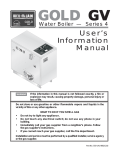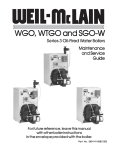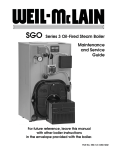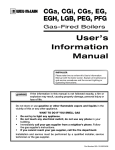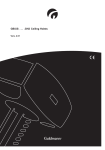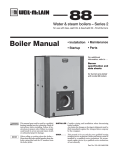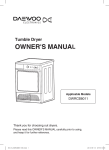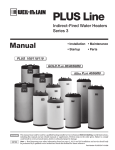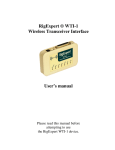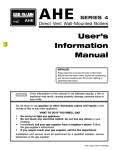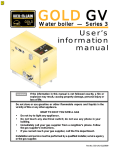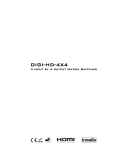Download Weil-McLain AlumniPEX Radiant Heater Technical information
Transcript
WGO, WTGO and SGO-W Series 3 Oil-Fir ed W ater Boilers Oil-Fired Water Maintenance and Service Guide For futur e rrefer efer ence, leave this manual future eference, with other boiler instructions in the envelope pr ovided with the boiler provided boiler.. Part No. 550-141-828/1202 Read This Page First Hazard Definitions Following terms are used to bring attention to the presence of hazards of various risk levels, or to important information concerning product life. DANGER Indicates presence of hazards that will cause severe personal injury, death or substantial property damage if ignored. WARNING Indicates presence of hazards that can cause severe personal injury, death or substantial property damage if ignored. CAUTION Indicates presence of hazards that will or can cause minor personal injury or property damage if ignored. NOTICE NOTICE Indicates special instructions on installation, operation, or maintenance that are important but not related to personal injury hazards. Symbol Definitions These symbols indicate information for and procedures to be followed by: Homeowner or person responsible for simple start-up and routine maintenance of boiler and system. Pages 2 through 6 must be followed to assure proper operation of your boiler. Page 7 lists common problems and possible corrections. In addition, it is your responsibility to: ● Have boiler and burner installed by a qualified installer. ● Have boiler and burner serviced annually by a qualified service technician. ● Review and understand start-up and routine maintenance procedures with qualified service technician. ● Perform routine maintenance as described on page 4. Qualified service technician who has the necessary equipment to check the boiler and system performance, and is responsible for start-up and service of boiler and system. Pages 2 and 3 and 8 through 11 must be followed to assure proper operation of this boiler. In addition, it is the responsibility of this person to: ● ● 2 Annually service boiler and burner to assure proper operation. See page 8 for service record. Review and explain start-up and routine maintenance procedures with homeowner. For Your Safety DANGER Follow instructions below to prevent severe personal injury, death or substantial property damage: ● Do not use crankcase drainings or any oil containing gasoline. See burner manual for proper fuel oil. ● Do not attempt to start burner when excess oil has accumulated in combustion chamber, when unit is full of vapor, or when combustion chamber is very hot. ● Do not start burner unless collector hood, flue cap, jacket cap, breeching and burner mounting door are secured in place. ● Never burn garbage or paper in the boiler. ● Never leave combustible material around boiler. ● DO NOT TAMPER WITH UNIT OR CONTROLS. Always follow specific instructions when starting up boiler or performing routine maintenance or service. Tips for water systems: ● CAUTION Failure to maintain recommended pH and repair leaks can cause section iron corrosion, leading to section failure and leaks. Do not use petroleum-based sealing or stop-leak compounds in boiler systems. Damage to system components can result, causing property damage. ● Boiler water pH 7.0 to 8.5 is recommended. For pH conditions outside 7.0 to 8.5 range or unusually hard water areas (above 7 grains hardness), consult local water treatment company. ● When using antifreeze: - Use antifreeze especially made for hydronic systems. Inhibited propylene glycol is recommended. WARNING Follow instructions below to prevent severe personal injury, death or substantial property damage: ● To avoid electric shock, disconnect electrical supply to burner service switch and additional external switches before performing service. ● To avoid severe burns, allow boiler to cool before performing service. ● Do not block flow of combustion or ventilation air to boiler. ● Boiler must be connected to a flue with sufficient draft at all times to assure proper operation. ● Do not use this boiler if any part has been under water. Electrical and mechanical failures may cause electric shock and fire risks. Immediately call a qualified service technician to inspect chimney or vent, boiler and burner. Have the boiler flueways cleaned and have the following replaced: — all electrical and mechanical controls — electrical wiring — oil burner and controls — insulation and chamber lining Check boiler and system piping for leaks. Continual makeup water will reduce boiler life. Minerals can build up in sections, reducing heat transfer and causing cast iron to overheat, resulting in section failure. WARNING Do not use automotive, ethylene glycol, undiluted or petroleumbased antifreeze. Severe personal injury, death or substantial property damage can result. - - - ● 50% solution provides protection to about -300F. Local codes may require back-flow preventer or actual disconnect from city water supply. Determine quantity according to system water content. Boiler water content is listed on back cover of Boiler Manual. Percent of solution will affect sizing of heat distribution units, circulator and expansion tank. Follow antifreeze manufacturer's instructions. Do not add cold water to hot boiler. Thermal shock can cause sections to crack. 3 Routine Maintenance Schedule The schedule below is specifically designed for the homeowner. Please read pages 2 and 3 before proceeding. Beginning each heating season: Call a qualified service technician to perform annual service. C End of heating season: C Daily during heating season: Check that boiler area is free from combustible materials, gasoline and other flammable vapors and liquids. C If tankless heater is installed, boiler will continue to operate. Check for the following: - All daily and weekly instructions listed on this page must be followed. - Burner motor may have to be oiled. Some motors are permanently lubricated and do not need additional oil. Check for oiling instructions on burner or motor. Weekly during heating season: C Check for and remove any obstructions to flow of combustion or ventilation air to boiler. C Check that breeching is attached between boiler and chimney. If breeching is loose or damaged, immediately turn off switch on boiler and call service technician to repair. Check for oil leaks in oil piping and around burner. If found, immediately call qualified service technician to correct situation. C C Check for water leaks in boiler and piping; also check for leaks around tankless heater plate, if installed. If found, immediately call service technician to repair. 4 Boiler shutdown: ● ● Do not drain boiler unless exposure to freezing temperatures will occur. Always keep manual fuel supply shut off if burner is shut down for an extended period of time. a. Turn off switch at boiler and any external switch to boiler. b. Close fuel valves. c. Turn off water feed valve. d. Cover burner to protect from dust and dampness. Start-up WGO/WTGO (see Figure 1): 1. If burner does not fire, check for: ● Service switch on boiler or additional switches turned off. ● Fuses or breaker switch tripped. ● Thermostat set below room temperature. ● Fuel valves turned off. ● Not enough oil in tank to supply burner. 2. Correct problems found in step #1. If burner does not fire, press reset button on burner primary control only once. Repeated presses will deposit oil in combustion chamber. DANGER Burner must never be fired when oil is in combustion chamber. Immediately call qualified service technician. 3. If burner still does not fire, call qualified service technician. Temperature Pressure Gauge Circulator n Water Relief Valve Combination Limit Control and Tankless Heater Control (on WTGO) n n Limit Control (on WGO) n Located in tankless heater plate n Service Switch on Boiler n n n Burner Disconnect Plug Reset Button on Burner Primary Control Burner Primary Control WGO and WTGO Boilers Figure 1 5 Start-up 2. Correct problems found in step #1. If burner does not fire, press reset button on burner primary control only once. Repeated presses will deposit oil in combustion chamber. SGO-W (see Figure 2): 1. If burner does not fire, check for: ● Service switch on boiler or additional switches turned off. ● Fuses or breaker switch tripped. ● Thermostat set below room temperature. ● Fuel valves turned off. ● Not enough oil in tank to supply burner. DANGER Burner must never be fired when oil is in combustion chamber. Immediately call qualified service technician. 3. If burner still does not fire, call qualified service technician. n Water Relief Valve (on back of boiler) Circulator n n Temperature Pressure Gauge Limit Control n Tankless Heater Control n Located in tankless heater plate n Service Switch on Boiler n n Burner Disconnect Plug 6 n n Reset Button on Burner Primary Control Burner Primary Control SGO-W Boiler Figure 2 COMMON PROBLEMS COMMON CAUSES Rapid cycling - burner turns on and off frequently. Thermostat installed where drafts or heat affect reading. Locate thermostat on inner wall away from heat sources or cool drafts. Heat anticipator in thermostat adjusted incorrectly. Adjust heat anticipator to match current draw. Refer to boiler wiring diagram. Incorrect limit setting. Have qualified service technician increase limit setting to decrease cycling. Maximum setting 220 deg. F. Need to frequently add makeup water. Leaks in boiler or piping. Have qualified service technician repair leaks at once to avoid constant use of makeup water. Popping or percolating noise heard in boiler. Mineral deposits in sections due to constant use of makeup water, or incorrect pH. Have qualified service technician de-lime boiler, repair leaks at once to avoid constant use of makeup water and check pH (between 7.0 and 8.5). Black water condition. Oxygen corrosion due to leaks in piping. Have qualified service technician repair leaks at once to avoid constant use of makeup water and check pH (between 7.0 and 8.5). Frequent release of water through relief valve. Expansion tank sized too small or water-logged. Have qualified service technician check expansion tank operation. Metal flakes found in flueway. Contaminated combustion air supply. Remove sources of hydrocarbons in or near boiler area. (Bleaches, cleaners, chemicals, sprays, fabric softeners, paint remover, etc.) Condensation of combustion gases. Have qualified service technician check boiler operation. Air in system. Bleed air from system through air vents in radiators or baseboard units. Low system pressure. Have qualified service technician check for leaks in boiler or piping at once. High limit set too low. Have qualified service technican adjust limit to higher setting. Mineral deposits insulate internal waterways of heater. Have qualified service technician delime or replace coil. Boiler stop-leak compound has been added to boiler water and is insulating outside of coil. Have qualified service technician remove and clean coil AND drain and flush boiler to remove stop-leak. Incorrect mixing valve setting for tankless heater. Have quaified service technican adjust mixing valve setting. Domestic flow rate too high. Have qualified service technician install flow check valve set to rating of tankless heater. Incorrect setting on tankless heater control. Have qualified service technician raise tankless control setting. Adjust differential on tankless control to lower setting. Some radiators or baseboard units do not heat or are noisy. Domestic water from tankless heater is hot then suddenly turns cold. OR Domestic water from tankless heater is always lukewarm. POSSIBLE CORRECTIONS NOTICE NOTICE The problems and corrections above represent common situations that can occur. There may be others not listed above. It is important always to contact a qualified service technician if you have any questions about the operation of your boiler or system. 7 Annual Service Check List The procedures and information on pages 7 through 11 are intended only for a qualified service technician who has the necessary equipment to inspect and adjust boiler and burner. A homeowner should never attempt these procedures. Qualified service technician must read pages 2 and 3 before proceeding. DANGER Annual Service Call Check List (follow in order listed below) D A T E D A T E D A T E D A T E D A T E D A T E D A T E D A T E D A T E D A T E Comments 1 Check that boiler area is free from combustible materials, gasoline and other flammable vapors and liquids. 2 Check for and remove any obstruction to combustion and ventilation air flow to boiler. 3 Check breeching and chimney or vent for obstructions, damage, etc. Repair or replace as necessary. 4 Clean boiler flueways. See page 9. 5 Perform service on relief valve and circulator. See page 11. 6 Check boiler and piping for leaks and repair if found. Check for leaks at tankless heater plate. Tighten nuts only if leaks are found (for WTGO torque to 20-25 ft.lbs.). 7 Inspect and adjust burner. See burner manual and: - change nozzle. - check ignition electrode settings. - clean blower housing and wheel. - make sure blower wheel turns freely. - oil burner motor if required. - clean air inlet. - clean or change fuel filter and strainer. 8 Make sure boiler is filled with water. 9 Start unit and verify combustion settings with combustion test equipment. See page 10. 10 Verify operation of all controls on boiler. See page 11. 8 Any parts of the boiler furnished by Weil-McLain must be replaced by parts listed in Weil-McLain Boiler and Repair Parts Book. Detailed Service Procedures Cleaning boiler flueways: DANGER Make sure all electrical connections to boiler are turned off and wait until boiler is warm, not hot, before cleaning. Failure to do so will result in severe personal injury, death or substantial property damage. 1. Top flue boilers -remove breeching and jacket top panel. Rear flue boilers - remove jacket top panel. 2. Remove flue collector hood, saving hardware for reassembly. 3. Shut off oil valves. Arrange drip pans under the areas of oil piping that will be disconnected. Disconnect oil line at burner so that you can swing open the door completely. 4. Line combustion chamber floor with newspaper to catch any soot that will be loosened in the cleaning process. 5. Starting at the top of the boiler, use a wire flue brush to thoroughly clean between all pins at all angles. Be careful not to damage side walls of rear refractory. 6. Move to the bottom of the flueways and clean up between the sections to reach pins left uncleaned in step #5. 7. Once the flueways are cleaned, carefully remove the paper from the floor of the combustion chamber. 8. Verify sealing rope around flue area is intact. Visually check condition and position of insulation in combustion chamber floor, and the refractories at the rear of boiler and in the burner mounting door. Replace any parts as necessary. 9. Close burner mounting door and tighten nut securely. Place flue collector hood on top of boiler. Secure with hardware from step #2. WARNING Maintain a gas-tight seal to avoid possible flue gas leakage and carbon monoxide emissions, which can lead to severe personal injury or death. 10. Check breeching for sooting and clean if necessary. Install jacket top panel and breeching. 11. Reconnect oil line and all electrical connections. Thoroughly clean flueways between all pins at all angles. Start on top of boiler, finish from the bottom. Cleaning Boiler Flueways Figure 3 9 Detailed Service Procedures Fill the system: To place in operation: 1. Close manual and automatic air vents and drain cock. 2. Fill to correct system pressure. Correct pressure will vary with each installation. Normal cold water fill pressure for residential systems is 12 psig. Boiler water pH 7.0 to 8.5 is recommended. DANGER Follow information below to prevent severe personal injury, death or substantial property damage: ● Do not use crankcase drainings or any oil containing gasoline. See burner manual for proper fuel oil. ● Do not attempt to start burner when excess oil has accumulated in combustion chamber, when unit is full of vapor, or when combustion chamber is very hot. ● Do not start burner unless collector hood, flue cap, jacket cap, breeching and burner mounting door are secured in place. ● Never burn garbage or paper in the boiler. ● Never leave combustible material around boiler. NOTICE Failure to maintain recommended pH level can cause section failure and leaks. 3. Open automatic air vent one turn. 4. a. Starting on the lowest floor, open air vents one at a time until water squirts out. Close vent. b. Repeat with remaining vents. 5. Refill to correct pressure. 1. Verify boiler is filled with water. 2. Open burner door and verify rear target wall, floor and burner door insulations are in proper condition and position. 3. Verify burner mounting door is closed and bolted tightly and burner plug is connected. 4. Refer to burner manual for burner start-up, adjustment and check-out procedures. Factory burner adjustment and settings may not be suitable for specific job conditions. WARNING Make final burner adjustments using combustion test equipment to assure proper operation. Do not fire boiler without water. Sections will overheat, damaging boiler and resulting in substantial property damage. 5. Check boiler and system piping for leaks. 6. Inspect breeching and venting for proper operation. 10 Detailed Service Procedures Controls requiring annual service: WATER RELIEF VALVE: CIRCULATOR: Check operation of water relief valve. Follow instructions on label fastened to relief valve. Follow oil-lubricating instructions on circulator. Over-oiling will damage circulator. Water-lubricated circulators do not need oiling. DANGER Scald potential. Do not check operation of relief valve unless discharge piping has been installed according to Boiler Manual. If piping is not in place, a qualified service technician must properly install piping. General description of control operation: TANKLESS WATER HEATER: AUTOMATIC AIR VENT: Weil-McLain tankless heater ratings are based on 2000F boiler water temperature. To get rated output, set tankless heater control to 2000F. Control can be adjusted to meet system hot water requirements. Air is released when cap is unscrewed one turn. If air vent leaks, remove small cap on top of vent, push in stem of valve and then release to clean valve seat. Screw cap completely on, then unscrew one turn. WATER RELIEF VALVE: Provides discharge if boiler pressure exceeds 30 psig. EXPANSION TANK: As water heats up, it expands. Tank provides a place for increased water volume. May be open, closed, or diaphragm-type. If relief valve opens frequently, expansion tank may be water-logged. Drain tank and re-establish proper air cushion. TEMPERATURE LIMIT CONTROL: 1. Open-type - Located above highest radiator or baseboard unit, usually in the attic or closet. Has a gauge glass and overflow pipe to drain. If high boiler water temperature occurs, control shuts down burner, but allows circulator to run as long as there is a call for heat. Limit should be set higher than temperature needed for the system. Maximum limit setting is 2200F. 2. Closed-type - Welded gas tight and located above boiler. Tank is partially filled with water, leaving an air cushion for expansion. CIRCULATOR: Circulator provides forced water circulation through boiler and piping system. PRESSURE-TEMPERATURE GAUGE: Provides reading of boiler pressure and temperature. Maximum boiler pressure is 50 psig, maximum water temperature is 2200F. Temperature will vary according to system and daily heating demands. The range will be from room temperature up to limit control setting. 3. Diaphragm-type - Welded gas tight with a rubber diaphragm to separate air from water. Tank must be located near boiler before inlet to circulator. An air vent must be installed in air vent tapping on boiler when this type of tank is used. This eliminates air in system. Normal cold water fill pressure is 12 psig. Tank pressure may be checked with an air pressure gauge. 11 Weil-McLain Limited Warranties Residential & Commercial Cast Iron Boilers Indirect-Fired Water Heaters Residential Water Warranty — Limited Lifetime Residential Water Heater Warranty — Limited Lifetime Residential Steam Warranty — Limited 10 Year Commercial Water Heater Warranty — Limited 15 Year Commercial Warranty — Limited 10 Year First Year — (Residential and Commercial Water Heaters) Weil-McLain warrants First Year — (All Residential & Commercial Cast Iron Boilers) Weil-McLain that its indirect-fired water heaters are free from defects in material and workmanship warrants that its cast iron boilers are free from defects in material and workmanfor one year from the date of installation. If any parts are found to be defective from ship for one year from date of installation. If any parts are found to be defective such defects, Weil-McLain will provide replacement of such defective parts. from such defects, Weil-McLain will provide replacement of such defective parts. Second Year and Beyond — (Residential Only) Second Through Tenth Year — (Residential & Commercial Water/Steam) Second Through Fifth Years — (Commercial Only) Weil-McLain warrants that the cast iron sections of its water and steam boilers are Weil-McLain warrants that the tank assembly components of its indirect-fired water free from defects in material and workmanship from the date of installation for the heaters are free from defects in material and workmanship for the second through second through the tenth year. If, during such time, any section is found to be the fifth year from the date of installation (commercial only), or for the second year defective, Weil-McLain will provide replacement of such defective section(s). from the date of installation and beyond (for residential only). If, during such time periods, a leak in the tank assembly should occur, Weil-McLain will provide replaceEleventh Year and Beyond — (Residential Water Only) Weil-McLain warrants that the cast iron sections of its residential water boilers are free from defects in ment for the original tank assembly. material and workmanship for the eleventh year and beyond from the date of Sixth Year through Fifteenth Year — (Commercial Only) Weil-McLain warrants installation. If, during such time period, any section(s) is found to be defective, that the tank assembly components of its commercial indirect-fired water heaters are Weil-McLain will provide replacement of such defective section(s) upon the free from defects in material and workmanship for the sixth year through the fifteenth payment of a proportionate charge based on the time the boiler has been in year following the date of installation. If, during such time period, a leak in the tank service. The proportionate charge will be equal to the appropriate percentage of assembly should occur, Weil-McLain will provide replacement for such defective tank the list price of such section(s) at the time the warranty claim is made, and will be assembly. Such replacement will be furnished with the nearest comparable model determined as follows: 11th year-5%; 12th year-10%; 13th year-15%; 14th yearavailable from Weil-McLain at the time of such replacement and upon payment of a 20%; 15th year-25%; 16th year-30%; 17th year-35%; 18th year-40%; 19th yearproportionate charge. Proportionate charges will be equal to the appropriate percent45%; 20th year-50%; 21st year-55%; 22nd year-60%; 23rd year-65%; 24th yearage of the current list price of such commercial indirect-fired water heater at the time 70%; 25th year & beyond -75%. warranty claim is made and will be determined as follows: 6th & 7th year-55%; 8th & 9th year-60%; 10th & 11th year-65%; 12th & 13th year-70%; 14th & 15th year-75%. These warranties do not cover boilers operated with combustion air contaminated externally by chemical vapors or with improper fuel additives, or with water These warranties do not cover: 1. Any water heater not initially installed with a new temperature-pressure relief valve conditions which may have caused unusual deposits in the cast iron sections. bearing the listing of the American Society of Mechanical Engineers (A.S.M.E.) at the See section “For all Weil-McLain Products” for additional warranty information. Weil-McLain Cast Aluminum Boilers Residential Warranty — Limited 15 Year First Through Fifth Year — Weil-McLain warrants that its cast aluminum boilers are free from defects in material and workmanship for one year from the date of installation and the heat exchanger is free from defects in material and workmanship for five years from the date of installation. If any parts in the first year, or the heat exchanger in the first five years are found to be defective from such defects, Weil-McLain will provide replacement of such defective parts or heat exchanger. In addition, Weil-McLain will provide a 5-Year “ Homeowner Protection Plan (“UHPP”) to cover parts and labor for five years from the date of installation provided only if the Ultra boiler is properly registered with the UHPP Administrator within one month of the date of installation. UHPP claims must be processed directly through the Plan Administrator and not through Weil-McLain. Sixth Through Tenth Year — Weil-McLain warrants that the heat exchangers of its cast aluminum boilers are free from defects in material and workmanship for the sixth through the tenth year from the date of installation. If, during such time, the heat exchanger is found to be defective, Weil-McLain will provide replacement of such defective heat exchanger. Eleventh Through Fifteenth Year — Weil-McLain warrants that the heat exchangers of its cast aluminum boilers are free from defects in material and workmanship for the eleventh through fifteenth year from the date of installation. If, during such time period, the heat exchanger is found to be defective, WeilMcLain will provide replacement for such defective heat exchanger upon the payment of a proportionate charge based on the time the boiler has been in service. The proportionate charge will be equal to the appropriate percentage of the list price of such heat exchanger at the time the warranty claim is made, and will be determined as follows: 11th year - 10%; 12th year - 20%; 13th year 40%; 14th year - 60%; 15th year - 80%; 16th year & beyond - 100%. This warranty does not cover boilers operated with combustion air contaminated externally by chemical vapors or with improper fuel additives, or with water/ system conditions which may have caused heat exchanger failure. See section “For all Weil-McLain Products” for additional warranty information. For All Weil-McLain Products: These warranties are subject to the condition that the Weil-McLain Product(s) must have been installed in accordance with manufacturers’ instructions by a heating contractor whose principal occupation is the sale and installation of plumbing, heating and/or air conditioning equipment. These warranties extend only to the first retail purchaser of the products and only to a product that has not been moved from its original installation site. In addition to each product warranty listed, Weil-McLain warranties do not cover: 1. Components that are part of the heating system (products) but were not furnished by Weil-McLain as a part of the heating system (products). 2. The workmanship of any installer of Weil-McLain’s product(s). In addition, this warranty does not assume any liability of any nature for unsatisfactory performance caused by improper installation. 3. Any costs for labor for removal and reinstallation of the alleged defective part, transportation to Weil-McLain, if necessary, and any other materials necessary to perform the exchange. 4. Any products that have a failure or malfunction resulting from improper or negligent operation, accident, abuse, freezing, misuse, unauthorized alteration or improper repair or maintenance. 5. Improper adjustments (including boiler/burner), control settings, care or maintenance. Information is in the installation, start-up, operations, owner/user’s manuals, service/maintenance instructions, and other printed/technical information provided with the product or direct from Weil-McLain or weil-mclain.com. 12 Part No. 550-141-828/1202 time of the water heater installation. 2. Any water heater that has a failure or malfunction resulting from a.) failure to keep the tank full of potable water; b.) failure to assure that water in the tank is free to circulate at all times; or c.) failure to keep the tank free of water sediment or scale deposits. 3. Any water heater that has potable water in the unit with a chloride or chlorine content higher than 80 mg/liter. 4. Any water heater installed in a residence containing any type of water softener system that is not installed and maintained in accordance with manufacturer’s specifications. 5. Any water heater installation where non-metallic piping products without an oxygen barrier are used. 6. Any water heater used for non-potable application such as pool or process heating. See section “For all Weil-McLain Products” for additional warranty information. Radiant Heating Products Radiant Heating Products Warranty — Limited 30 Year IPP & IPC Products Warranty — Limited 3 Year Weil-McLain warrants that its AlumiPex and Qual-Pex radiant heating products are free from defects in material and workmanship for thirty years (three years for IPP and IPC products) from the date of installation. If any parts are f ound to be defective from such defects during such time period, Weil-McLain will provide replacement of such defective parts. It is expressly understood that failure as a result of freezing of water within the pipes (tubing) does not constitute a defect in material or workmanship and shall not be covered by this warranty. See section “For all Weil-McLain Products” for additional warranty information. Parts and Accessories Parts and Accessories Warranty — Limited 1 Year Weil-McLain warrants that parts and accessories that were purchased through WeilMcLain are free from defects in material and workmanship for one year from the date of installation. If any parts and/or accessories are found to be defective from such defects during such time period, Weil-McLain will provide replacement of such defective parts. Parts and accessories covered under this warranty include only those items that are not covered under other Weil-McLain product warranties. See section “For all Weil-McLain Products” for additional warranty information. NOTE: Residential warranties do not cover any residential products installed in buildings other than one or two family dwelling units, unless they are buildings with individual residential products for each dwelling unit. THE WARRANTIES DESCRIBED HEREIN ARE IN LIEU OF ALL OTHER WARRANTIES, EXPRESS OR IMPLIED, INCLUDING BUT NOT LIMITED TO ANY IMPLIED WARRANTIES OF FITNESS FOR A PARTICULAR PURPOSE AND MERCHANTABILITY. WEIL-McLAIN EXPRESSLY DISCLAIMS AND EXCLUDES ANY LIABILITY FOR CONSEQUENTIAL, INCIDENTAL, INDIRECT OR PUNITIVE DAMAGES FOR BREACH OF ANY EXPRESS WARRANTY. For prompt product warranty claims, notify the installer who, in turn, will notify the Weil-McLain distributor from whom he purchased the boiler. If this action does not result in warranty resolution, contact Weil-McLain Consumer Relations Department, 500 Blaine Street, Michigan City, Indiana 46360, with details in support of the warranty claim. Alleged defective part or parts must be returned through the same trade channel in accordance with the Weil-McLain procedure currently in force for handling returned goods for the purpose of inspection to determine cause of failure. Weil-McLain will furnish new part(s) to an authorized Weil-McLain distributor who, in turn will furnish the new part (s) to the heating contractor who installed the boiler. If you have any questions about the coverage of this warranty, contact Weil-McLain at the address above.












